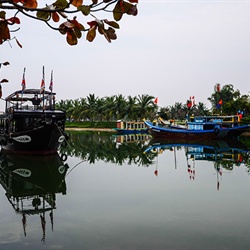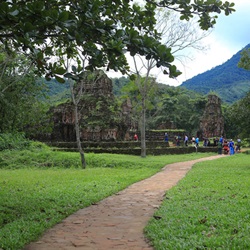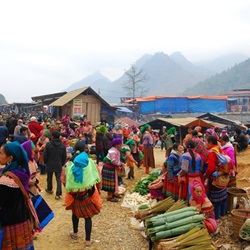Thanh Ha Commune (Thanh Liem) is located near the National Route No.1A having 2,626 households with 9,699 people in seven villages. Out of 2,626 households, approximate 2,002 are working in the embroidery industry, accounting for 76.2% recruiting about 5,740 labourers, of which 2,684 are senior workers, approximate 2,896 junior workers and 160 hired workers. These figures mean that Thanh Ha is the commune having the highest number of households and employees participating in the embroidery industry.
After the complete liberation of the North, the trade village has expanded in dimension and attracted thousands of labourers; the embroidery profession has been widely propagated; the production has continually developed. The 1975-1989 is the prosperous period of the trade village: products diversely met the demand of the domestic consumption and exported to Russia and the East Europe. From 1990 to present is the mechanism change period: Thanh Ha embroidery village has found the way to exist and develop while traditional markets are contracted and foreign markets are very strict on quality and time requirements.
The facility of the embroidery village is very simple. Most of labour is manual. The whole village has over 5,000 weaving frames; 30 households have washing and printing facilities; and other facilities can include needle, crochet hook, knife and scissors.
Stages of the embroidery process: material preparation, design, mix colours and print, embroidering, washing and ironing, packing and lastly marketing. These stages are carried out by manual labour.
To achieve quality designs, there are only some households who are capable of techniques and funds conducting the design stage for the whole village. The inspecting, packing and marketing stages are carried out by enterprises (who are assigned to sell products for the village). Labourers only perform one stage: embroidering.

The embroidery industry has such characteristics as: materials are consumed little; yet the labour required for the work is intensive hence the product value is high. However, the price of the embroidery products depends on two factors: materials and designs which are preferred by the customers or not. Currently, favourite products are bed cover sheets, pillows and table clothes.
To develop the trade village, Thanh Ha people has invested in marketing and establishing many advertising shops nationwide, and continually improved the product quality and design meeting the requirement of fastidious markets. Currently, in Thanh Ha, most of households work for enterprises. In Thanh Liem district, there are two limited liability companies and three private enterprises who invested VND 2.2 billion on embroidery production to find markets and create employments for thousands of people including Thanh Ha embroidery village.
Thanh Ha embroidery village has no difficulties in material sources. Cloth and thread is available. However, funding is a problem. This is the fund to purchase the materials and that stuck in the circulation process. According to the investigation results of the Industry Department, the value of fixed assets is approximate VND 30 million/households; and the floating capital is averagely VND 250,000/household.
In Thanh Ha, most of the capital is self-sufficient. Loans are only short-term; medium- and long-term loans have not been provided for the village by banks. Money when needs to be mobilized are borrowed from private traders. By the end of June 1999, preferential interest loans for the village are modestly at VND 300 million while the demand is approximate VND 1.6 billion. For the export embroidery industry, loan is highly necessary because most customers purchase definitively and convey to others but not processing.
In 1999, Thanh Ha employees produced 88,500 products valuing at VND 9.44 billion. A number is not small for any trade villages. However, the monthly salary of each employee is not similar depending on many factors including: capital, skill and how fast the product sells?
The average salary of high skill workers is about VND 300,000-350,000/month, and of low skill workers is approximate VND 200,000-250,000/month. In other words, each household with two main workers and two low- to medium-skill assistants has an income of VND 800,000-1,000,000/month and approximate VND 10 million/year. This income is not small for rural workers.
Workers in Thanh Ha hope the Government to issue some preferential interest loan policies for the trade village and to support the training for embroidery workers; and wish functional offices such as the Department of Industry, the Department of Science, Technology and Environment and the Department of Planning - Investment to support in finding foreign markets and solutions to reduce the price compelled by intermediary export enterprises.
The trade village development is to exploit the available potentials of labour, technique, capital and material to make products meeting the consumption and export demands. In addition, the trade village development also contributes to change the labour composition in the rural areas reducing the unemployment rate, eliminating hunger and reducing poverty as well as improving the living standards of the majority of farmers. Coming to Thanh Ha today, we will believe in the new worker generation who are asserting themselves and succeeding in the market mechanism.
(Source: hanam)









.png)










COMMENTS